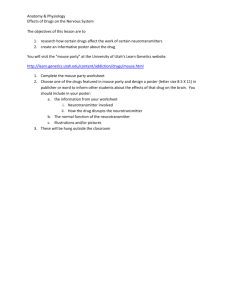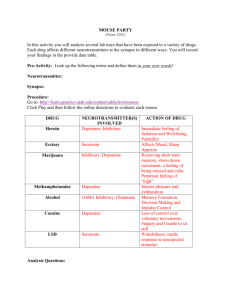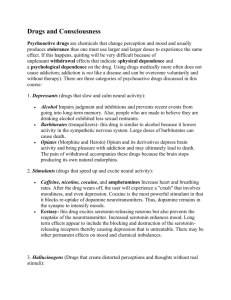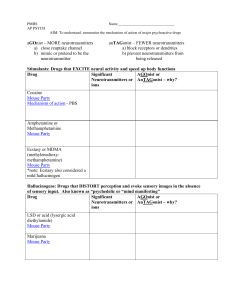Drugs of Abuse
advertisement
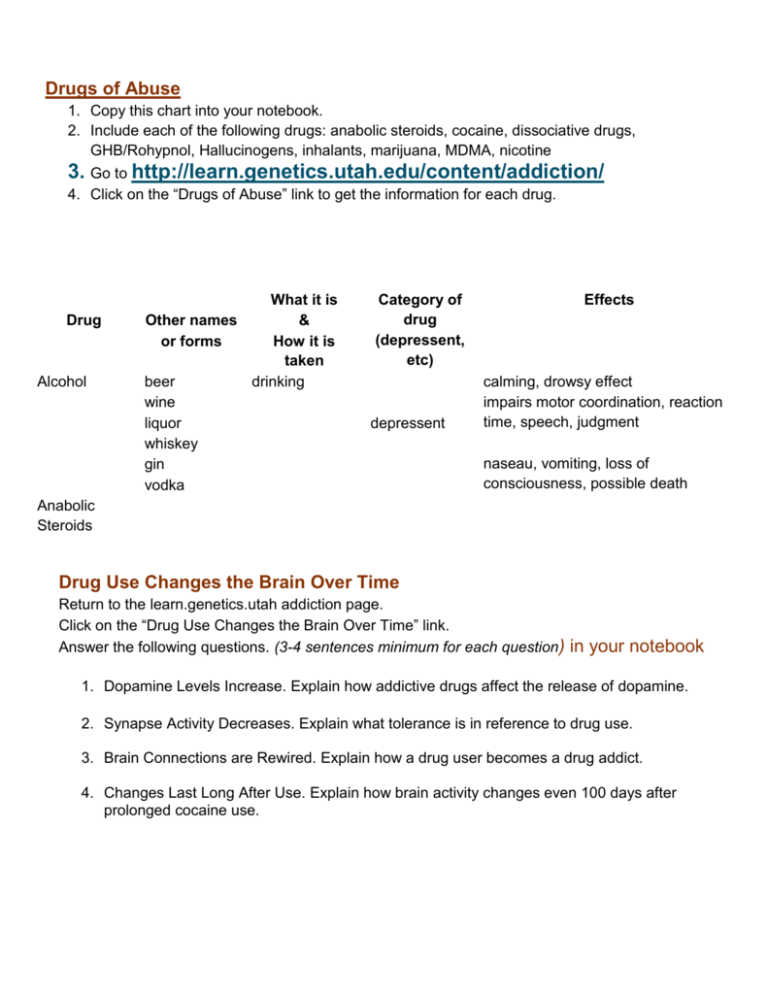
Drugs of Abuse 1. Copy this chart into your notebook. 2. Include each of the following drugs: anabolic steroids, cocaine, dissociative drugs, GHB/Rohypnol, Hallucinogens, inhalants, marijuana, MDMA, nicotine 3. Go to http://learn.genetics.utah.edu/content/addiction/ 4. Click on the “Drugs of Abuse” link to get the information for each drug. Drug Alcohol What it is Other names & or forms How it is taken beer drinking wine liquor whiskey gin vodka Category of drug (depressent, etc) depressent Effects calming, drowsy effect impairs motor coordination, reaction time, speech, judgment naseau, vomiting, loss of consciousness, possible death Anabolic Steroids Drug Use Changes the Brain Over Time Return to the learn.genetics.utah addiction page. Click on the “Drug Use Changes the Brain Over Time” link. Answer the following questions. (3-4 sentences minimum for each question) in your notebook Dopamine Levels Increase 1. Dopamine Levels Increase. Explain how addictive drugs affect the release of dopamine. 2. Synapse Activity Decreases. Explain what tolerance is in reference to drug use. 3. Brain Connections are Rewired. Explain how a drug user becomes a drug addict. 4. Changes Last Long After Use. Explain how brain activity changes even 100 days after prolonged cocaine use. Mouse Party Click on the “Mouse Party” link. There are 7 mice in the tank and each has been exposed to a different drug. Drag each mouse to the chair to see what is happening in the brain of the mouse exposed to each drug. Answer the following questions for each drug. Mouse #S153V – Heroine What neurotransmitter(s) does this drug interfere with? How specifically does this drug affect these neurotransmitters and/or receptors in the brain? How does this affect the person’s mood and/or actions when he/she is on the drug? How specifically does this drug affect these neurotransmitters and/or receptors in the brain? How does this affect the person’s mood and/or actions when he/she is on the drug? How specifically does this drug affect these neurotransmitters and/or receptors in the brain? How does this affect the person’s mood and/or actions when he/she is on the drug? Mouse #S244R – Methamphetamine What neurotransmitter(s) does How specifically does this drug this drug interfere with? affect these neurotransmitters and/or receptors in the brain? How does this affect the person’s mood and/or actions when he/she is on the drug? Mouse #S324M – Ecstasy What neurotransmitter(s) does this drug interfere with? Mouse #S234Z – Marijuana What neurotransmitter(s) does this drug interfere with? Mouse #S322C – Alcohol What neurotransmitter(s) does this drug interfere with? How specifically does this drug affect these neurotransmitters and/or receptors in the brain? How does this affect the person’s mood and/or actions when he/she is on the drug? How specifically does this drug affect these neurotransmitters and/or receptors in the brain? How does this affect the person’s mood and/or actions when he/she is on the drug? How specifically does this drug affect these neurotransmitters and/or receptors in the brain? How does this affect the person’s mood and/or actions when he/she is on the drug? Mouse #S256A – Cocaine What neurotransmitter(s) does this drug interfere with? Mouse #S186J – LSD What neurotransmitter(s) does this drug interfere with? Review Questions - on a separate sheet of paper complete the following 1.What is drug addiction? 2.Approximately how much does drug abuse and addiction cost the U.S. annually? What are some ways this might be fixed? 3.How do drugs impact the brain? 4.What is tolerance and how can it lead to drug abuse and addiction? 5. Did more or less 10th graders use alcohol than you expected? More or less 12th graders? 6. Did more or less 10th graders use drugs than you expected? More or less 12th graders? 7. What do you think has caused the decrease in alcohol and cigarette use in high school age students since 1992? 8.Describe stimulants and give one example. 9.Describe depressants and give one example. 10.Describe inhalants and give one example. 11.Describe opioids and give one example. 12.Describe hallucinogens and give one example.
